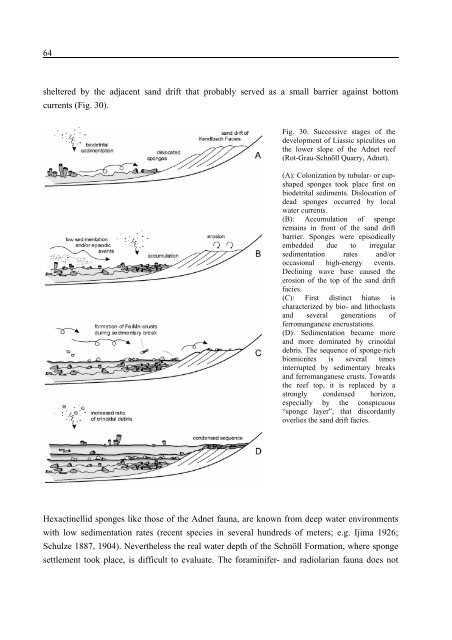Porifera-microbialites of the Lower Liassic (Northern Calcareous ...
Porifera-microbialites of the Lower Liassic (Northern Calcareous ...
Porifera-microbialites of the Lower Liassic (Northern Calcareous ...
You also want an ePaper? Increase the reach of your titles
YUMPU automatically turns print PDFs into web optimized ePapers that Google loves.
64<br />
sheltered by <strong>the</strong> adjacent sand drift that probably served as a small barrier against bottom<br />
currents (Fig. 30).<br />
Fig. 30. Successive stages <strong>of</strong> <strong>the</strong><br />
development <strong>of</strong> <strong>Liassic</strong> spiculites on<br />
<strong>the</strong> lower slope <strong>of</strong> <strong>the</strong> Adnet reef<br />
(Rot-Grau-Schnöll Quarry, Adnet).<br />
(A): Colonization by tubular- or cupshaped<br />
sponges took place first on<br />
biodetrital sediments. Dislocation <strong>of</strong><br />
dead sponges occurred by local<br />
water currents.<br />
(B): Accumulation <strong>of</strong> sponge<br />
remains in front <strong>of</strong> <strong>the</strong> sand drift<br />
barrier. Sponges were episodically<br />
embedded due to irregular<br />
sedimentation rates and/or<br />
occasional high-energy events.<br />
Declining wave base caused <strong>the</strong><br />
erosion <strong>of</strong> <strong>the</strong> top <strong>of</strong> <strong>the</strong> sand drift<br />
facies.<br />
(C): First distinct hiatus is<br />
characterized by bio- and lithoclasts<br />
and several generations <strong>of</strong><br />
ferromanganese encrustations.<br />
(D): Sedimentation became more<br />
and more dominated by crinoidal<br />
debris. The sequence <strong>of</strong> sponge-rich<br />
biomicrites is several times<br />
interrupted by sedimentary breaks<br />
and ferromanganese crusts. Towards<br />
<strong>the</strong> reef top, it is replaced by a<br />
strongly condensed horizon,<br />
especially by <strong>the</strong> conspicuous<br />
“sponge layer”, that discordantly<br />
overlies <strong>the</strong> sand drift facies.<br />
Hexactinellid sponges like those <strong>of</strong> <strong>the</strong> Adnet fauna, are known from deep water environments<br />
with low sedimentation rates (recent species in several hundreds <strong>of</strong> meters; e.g. Ijima 1926;<br />
Schulze 1887, 1904). Never<strong>the</strong>less <strong>the</strong> real water depth <strong>of</strong> <strong>the</strong> Schnöll Formation, where sponge<br />
settlement took place, is difficult to evaluate. The foraminifer- and radiolarian fauna does not

















